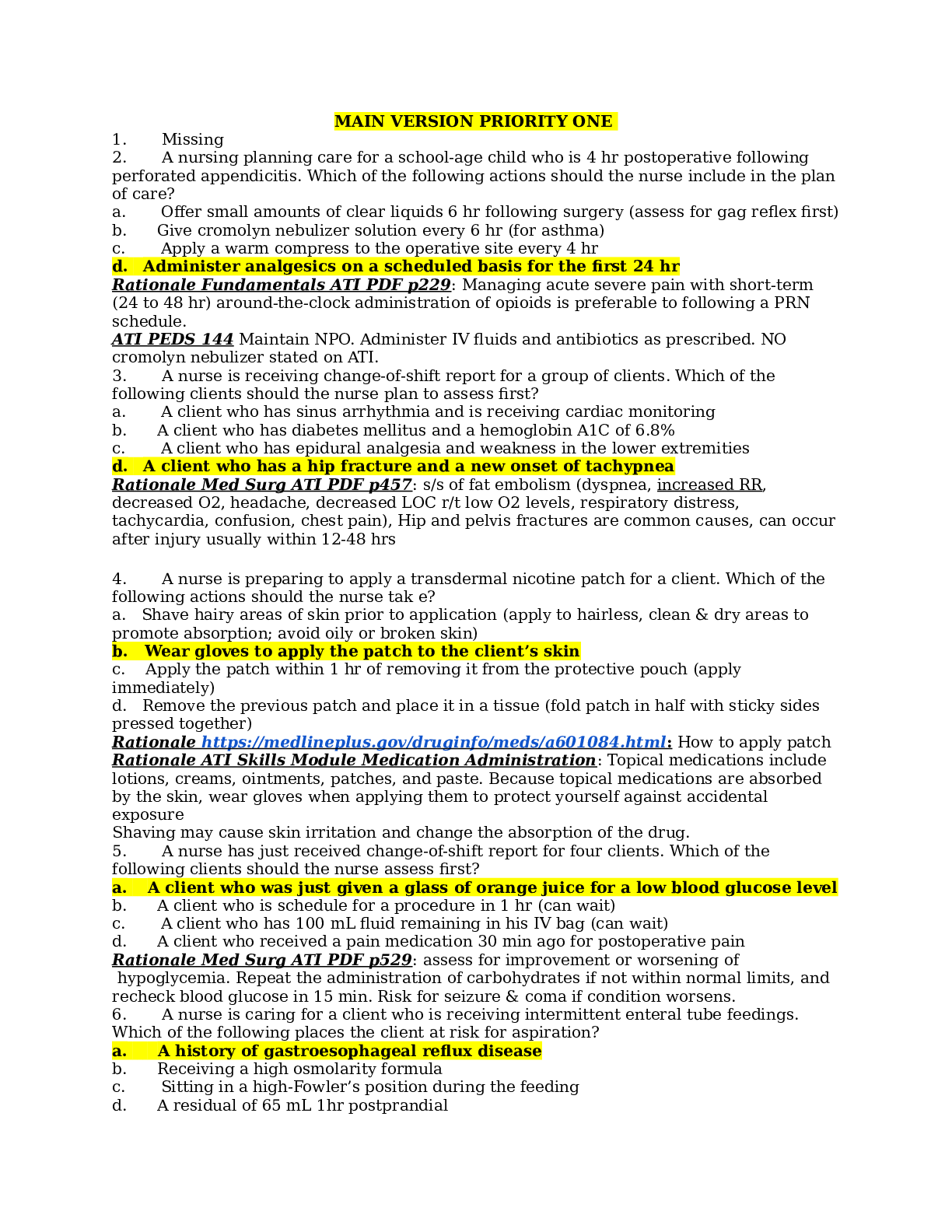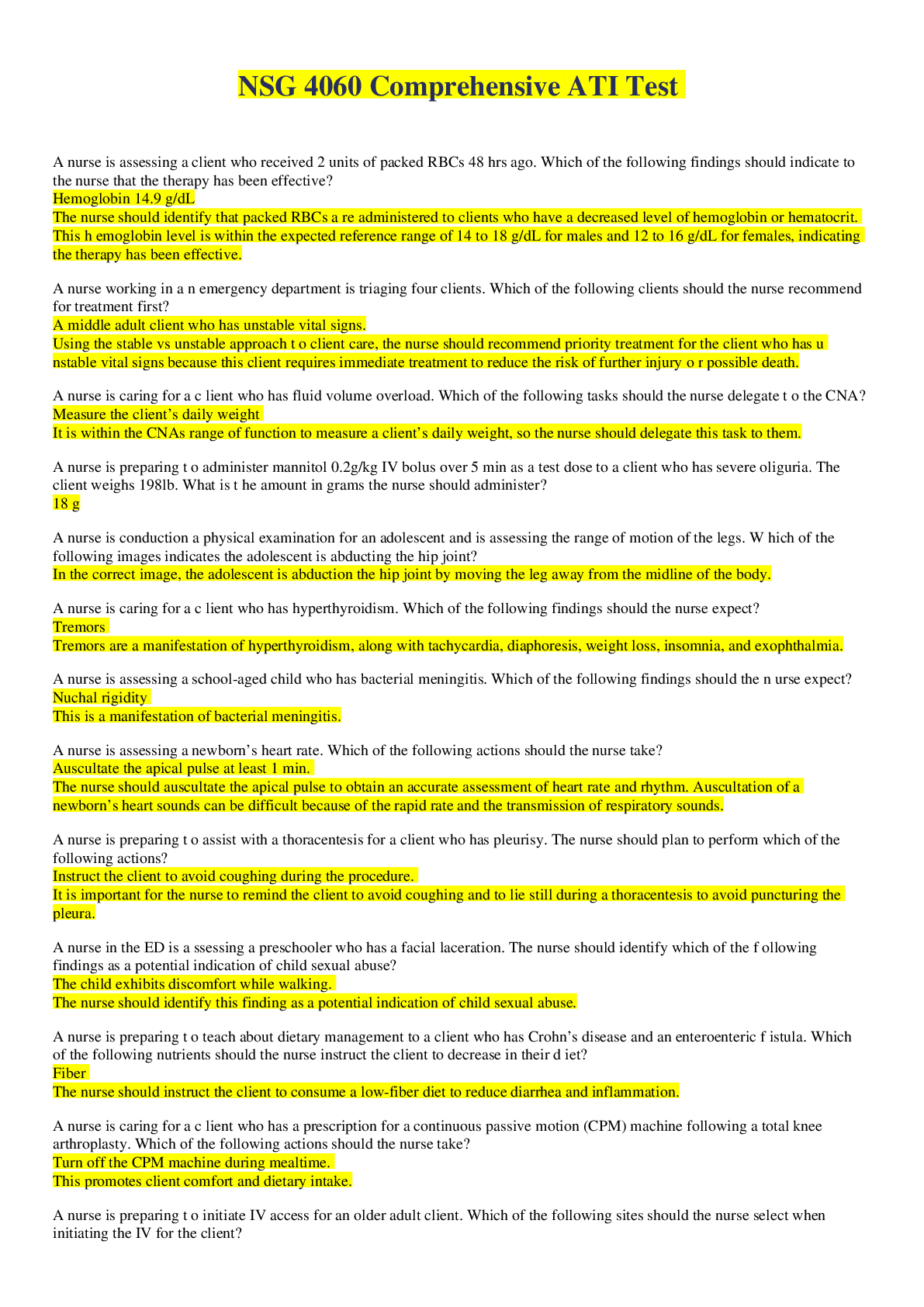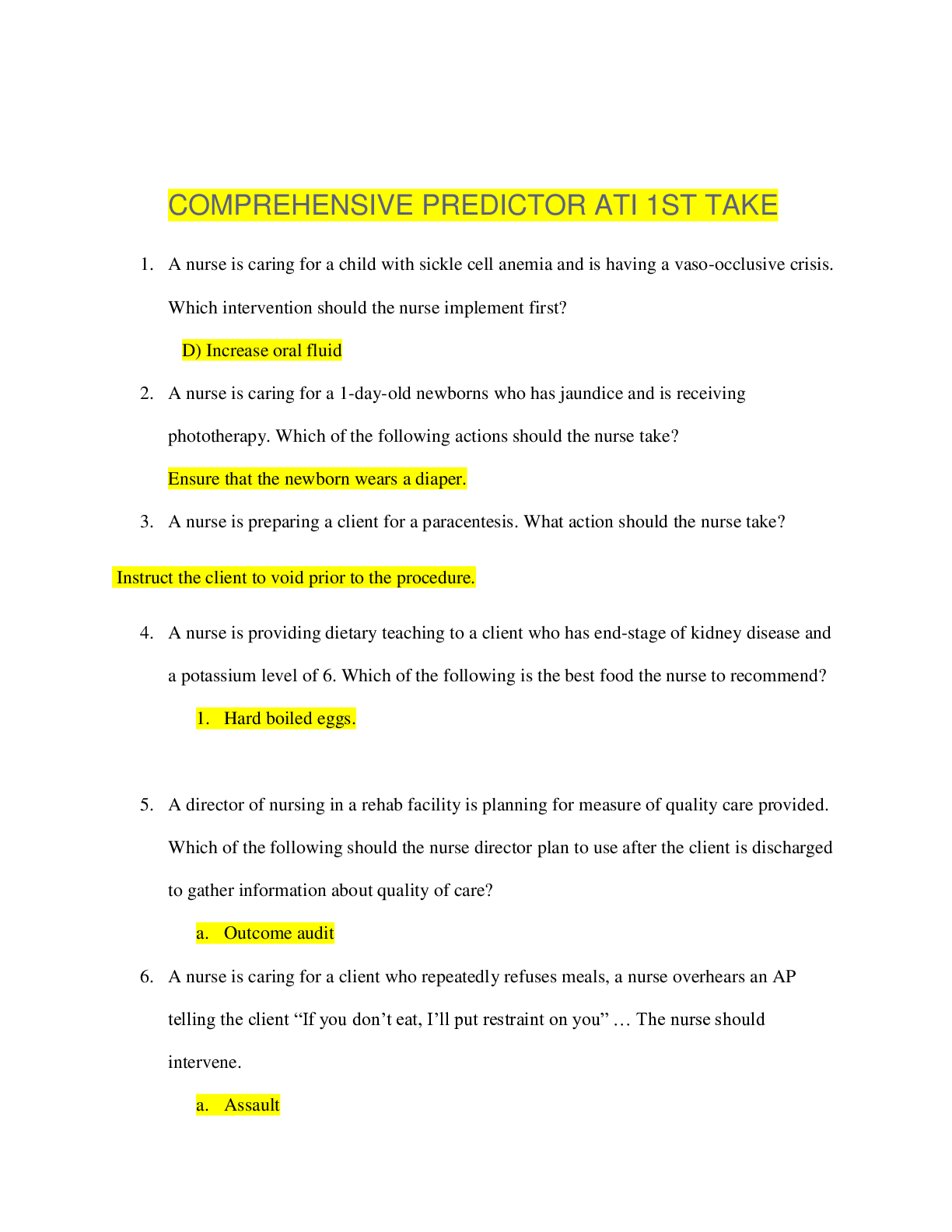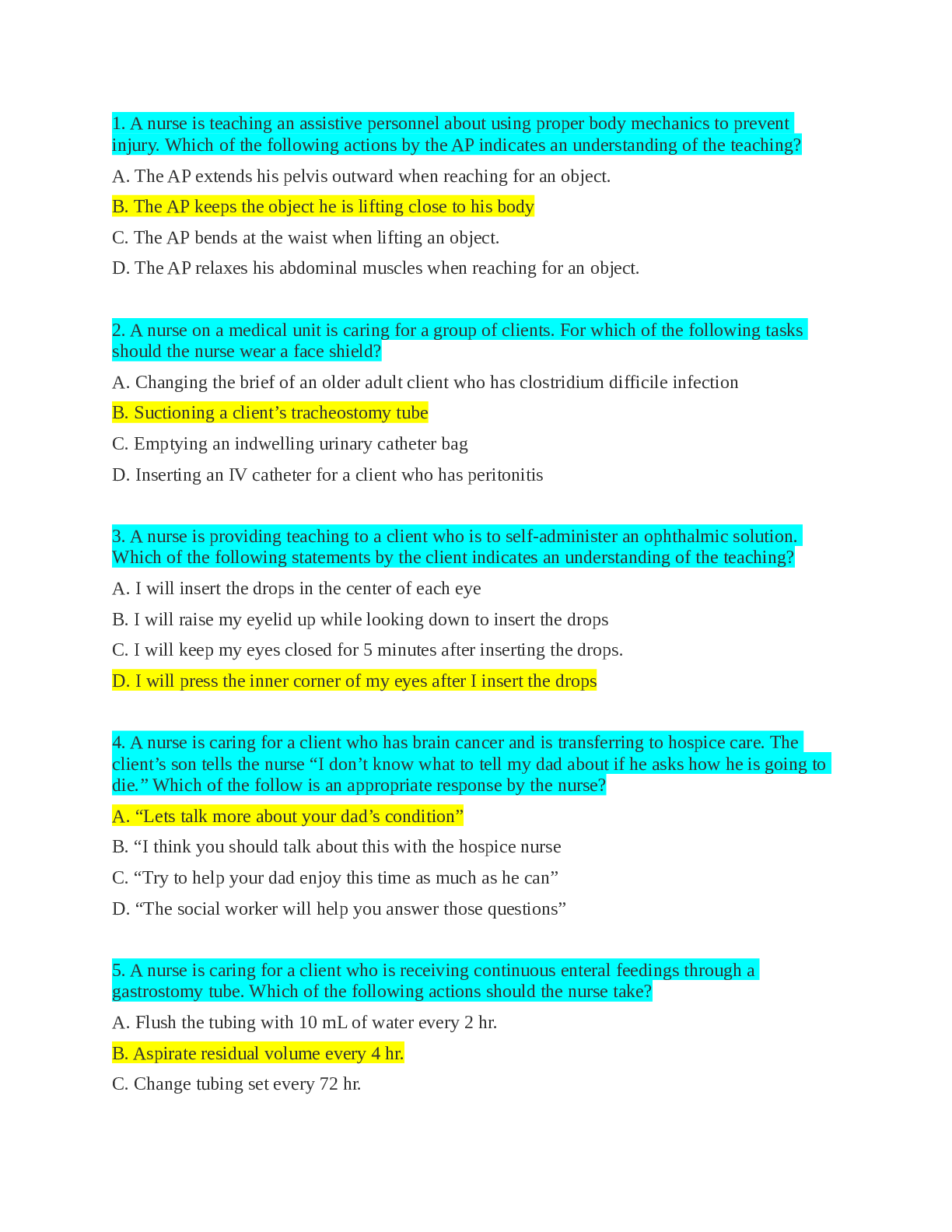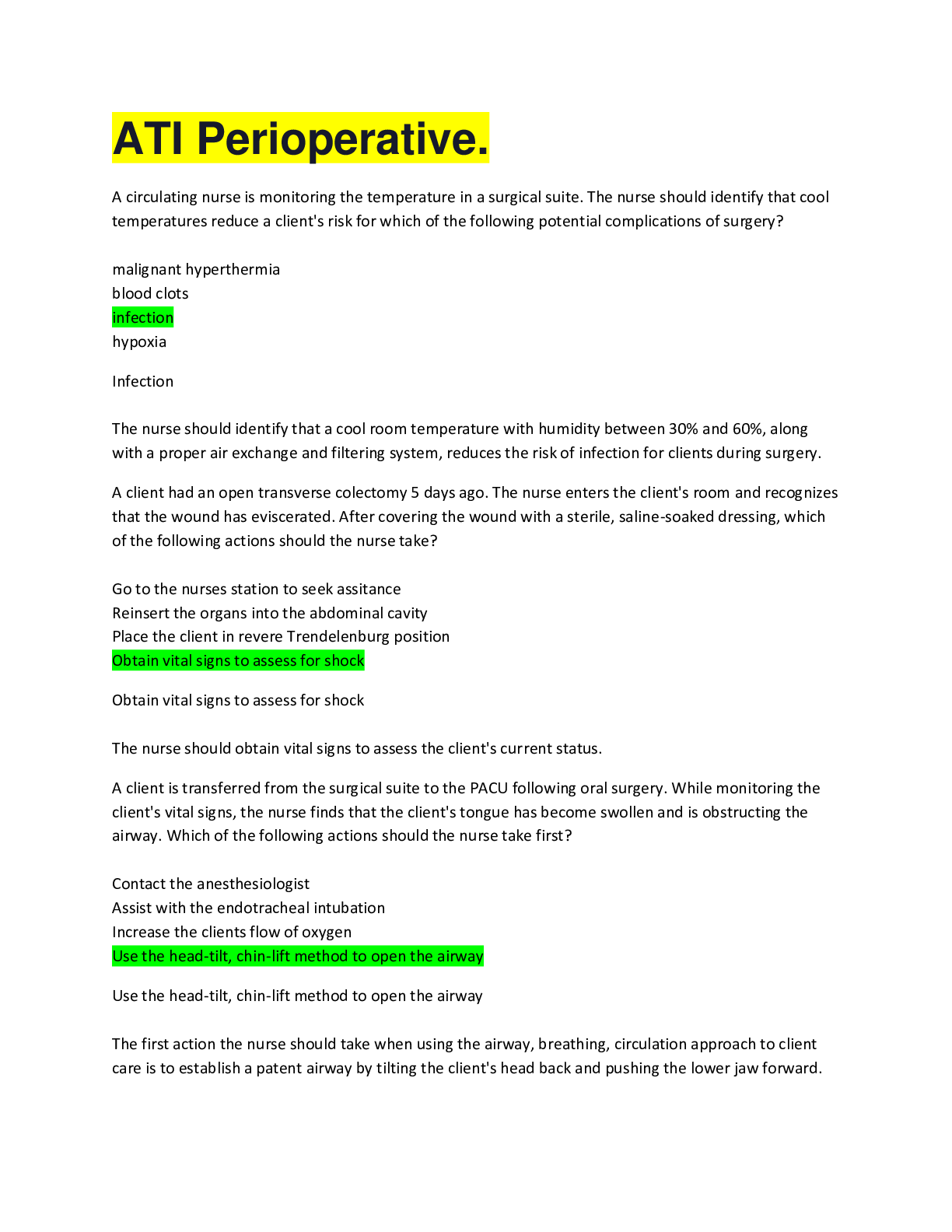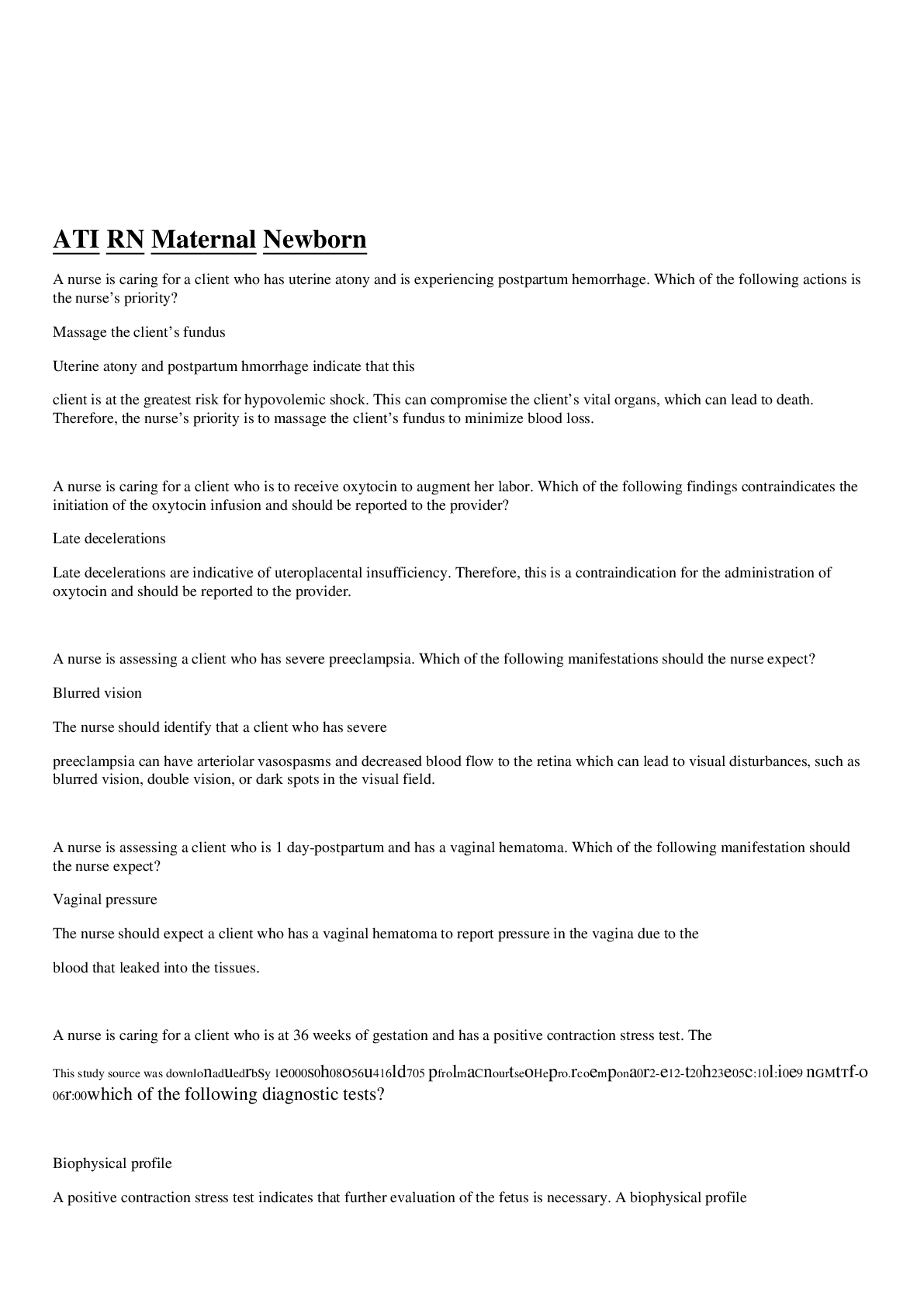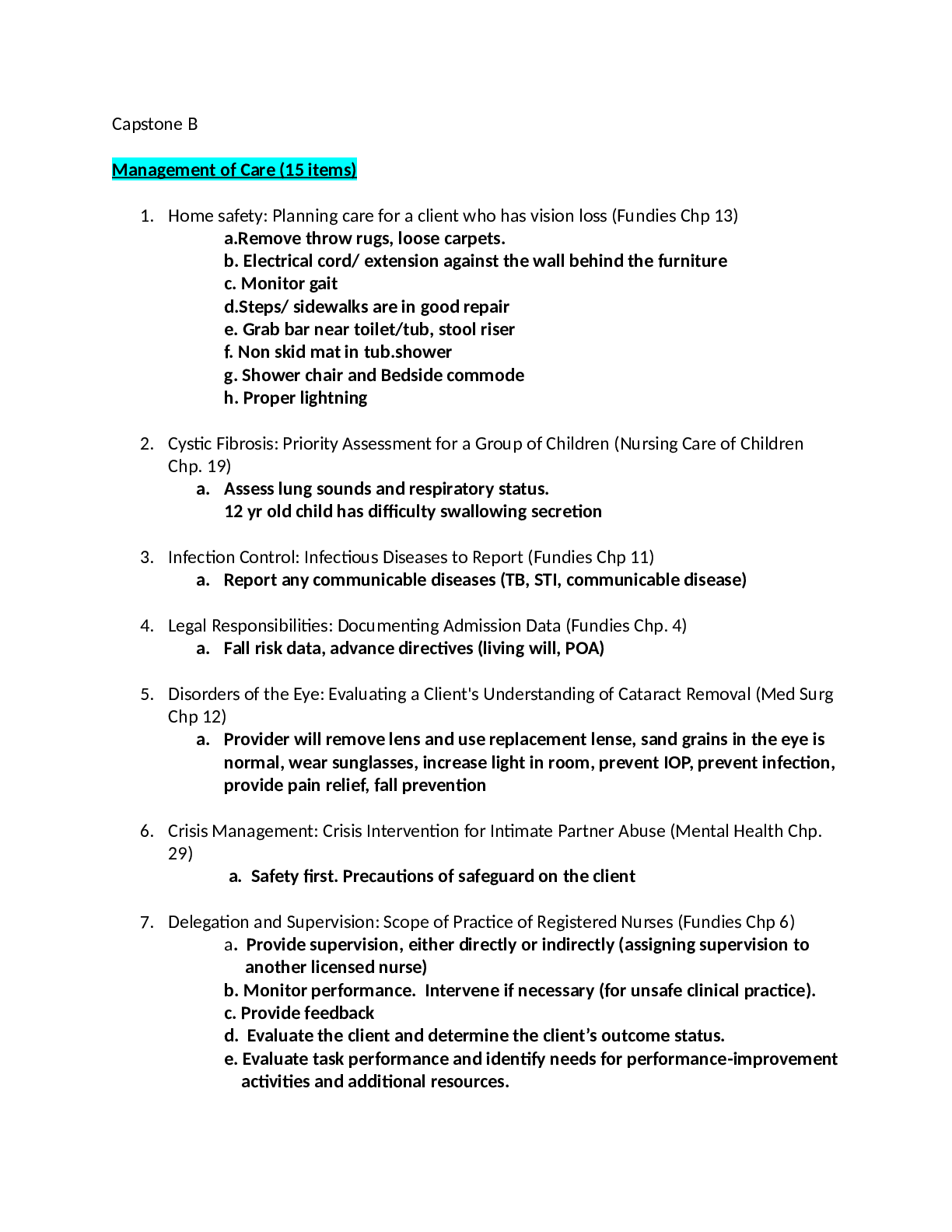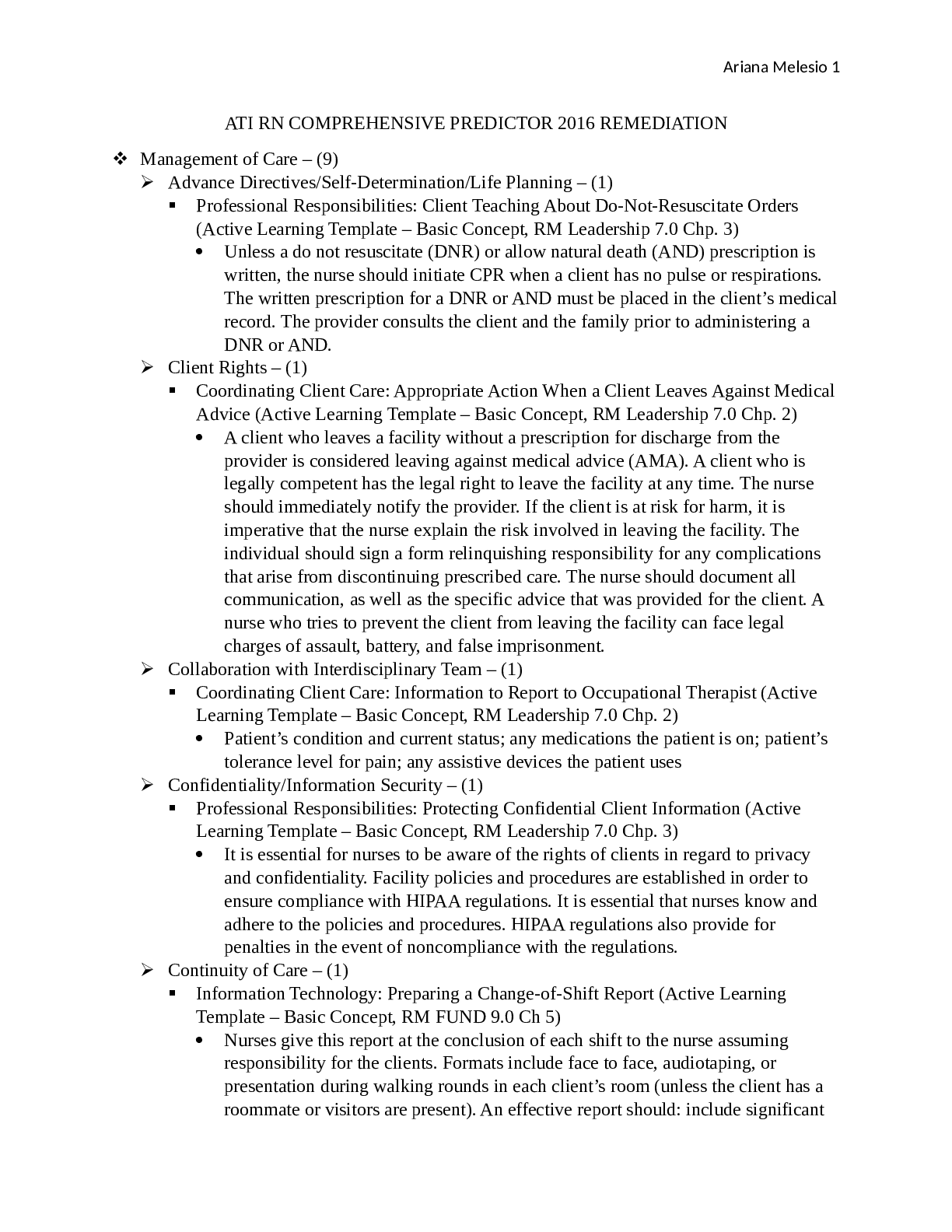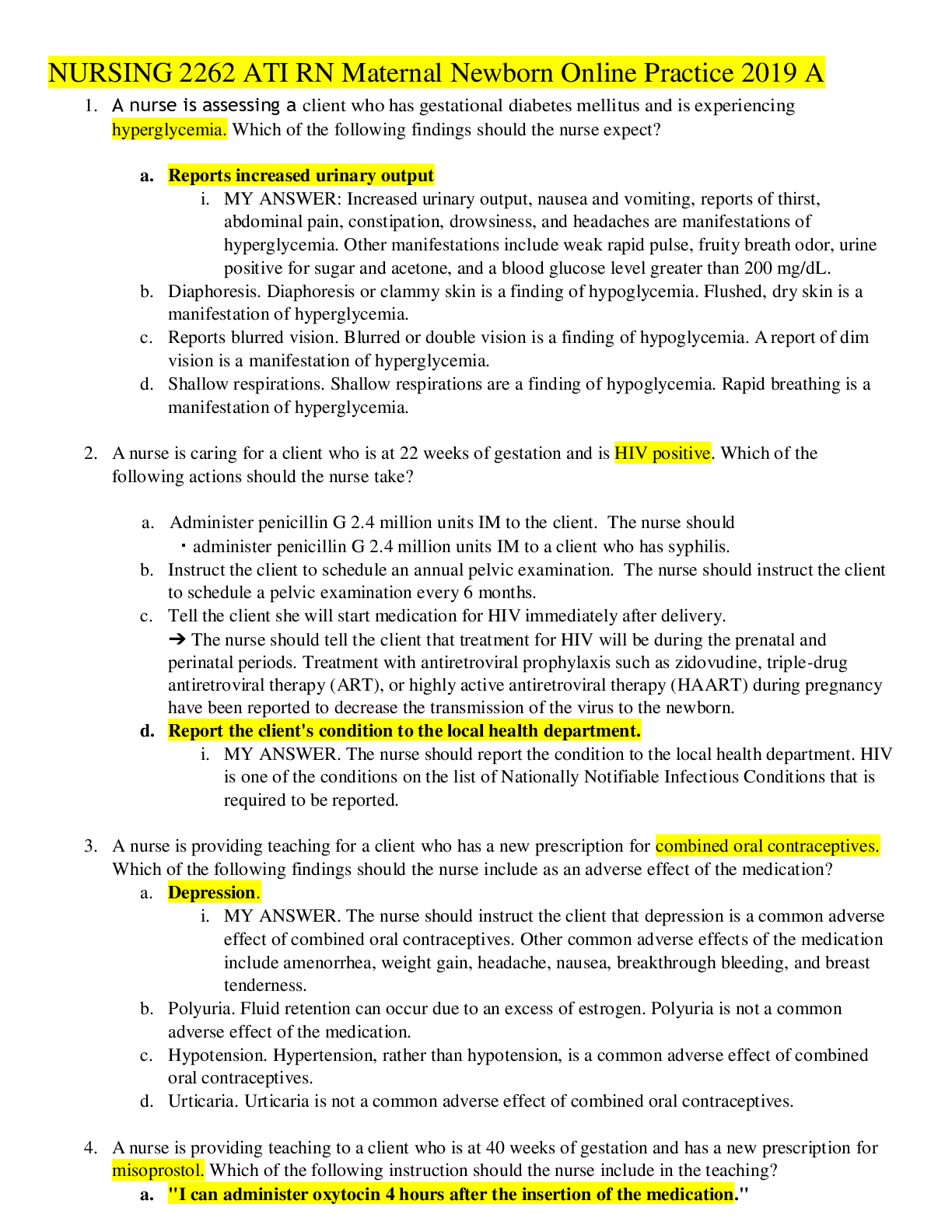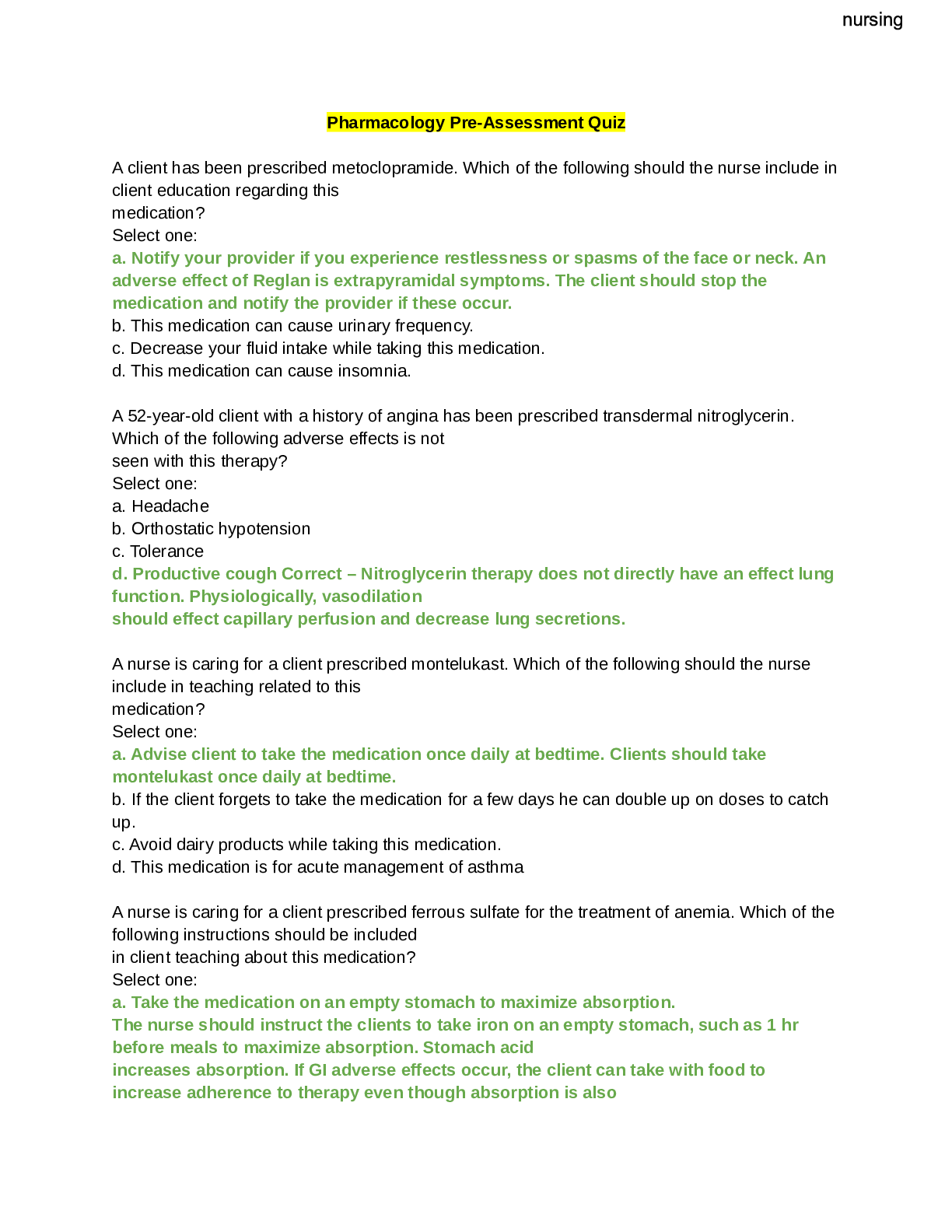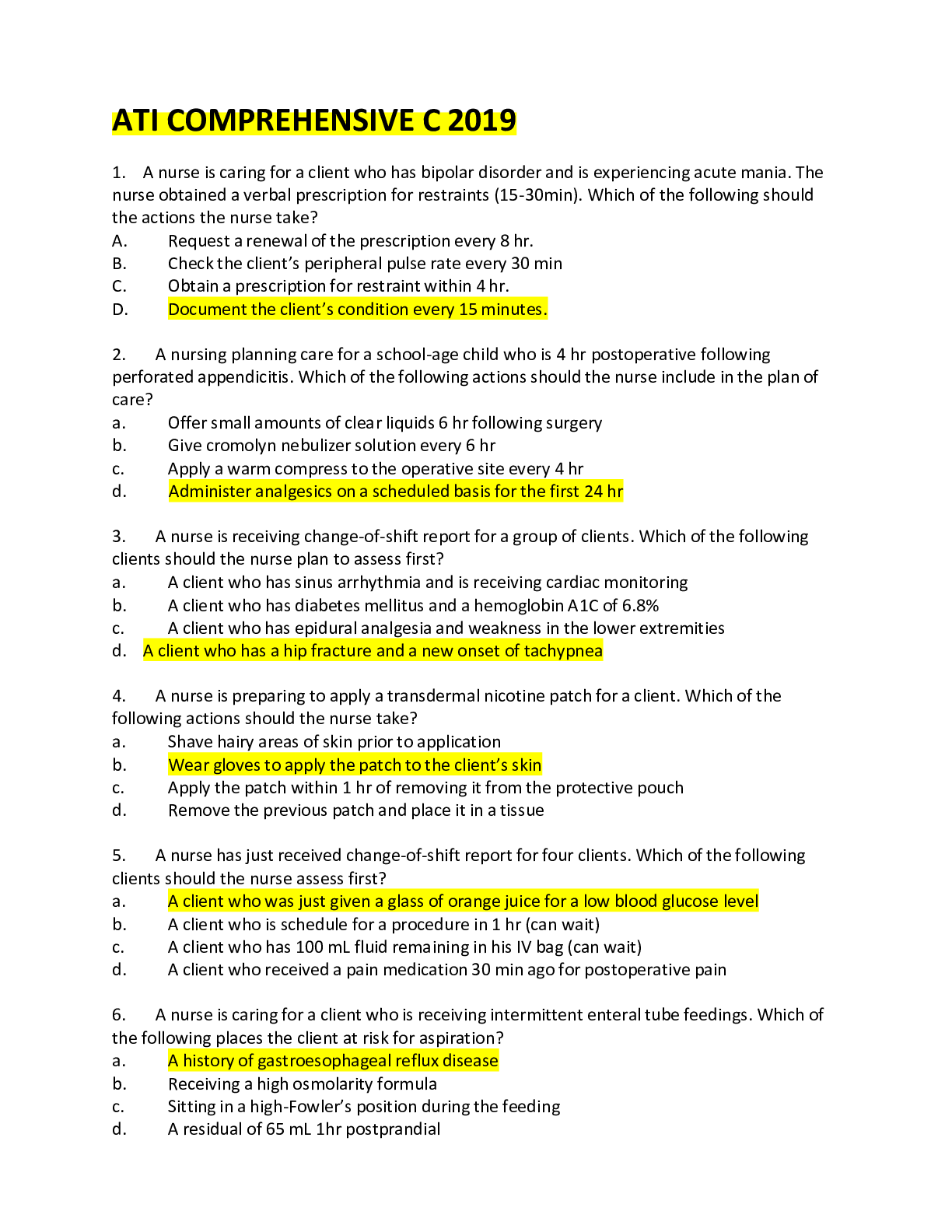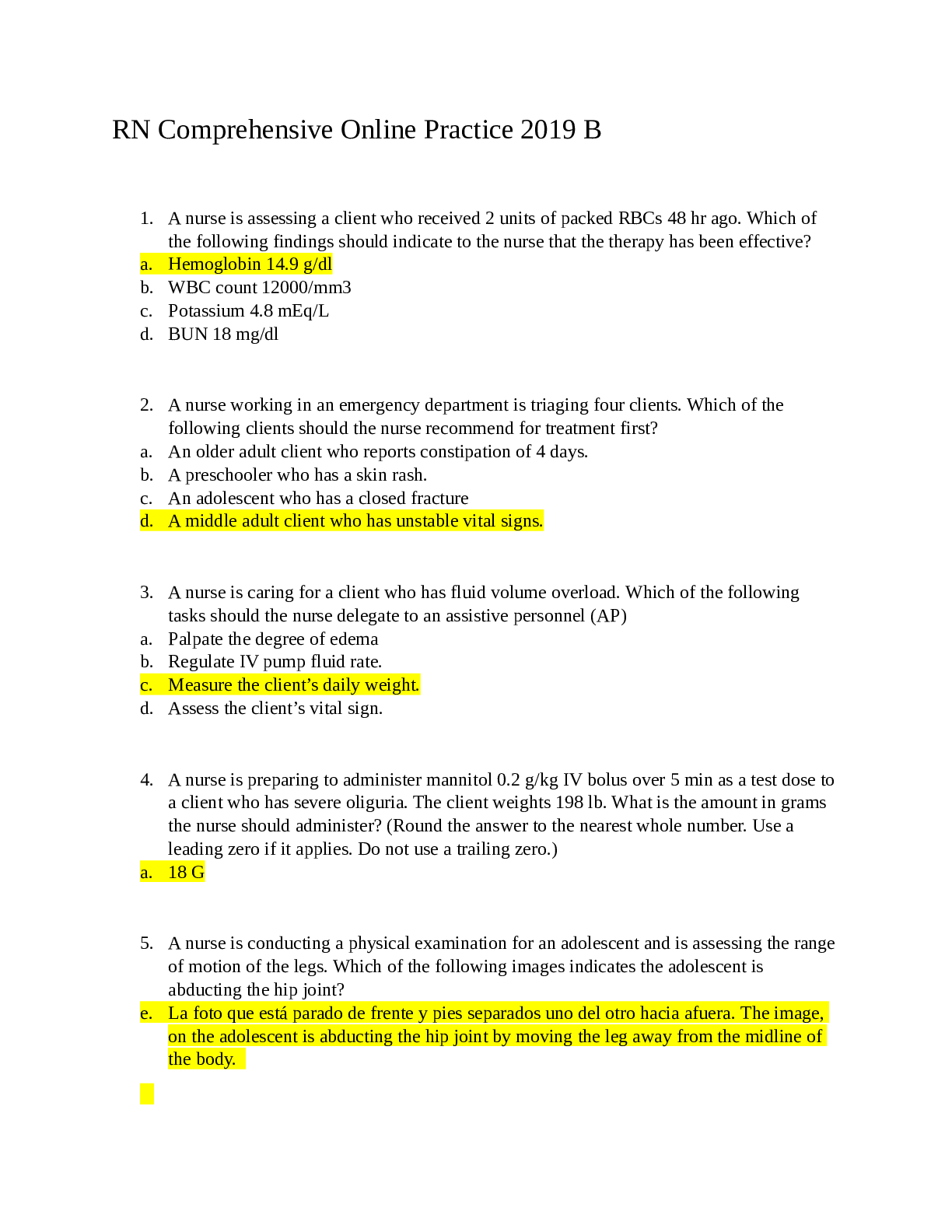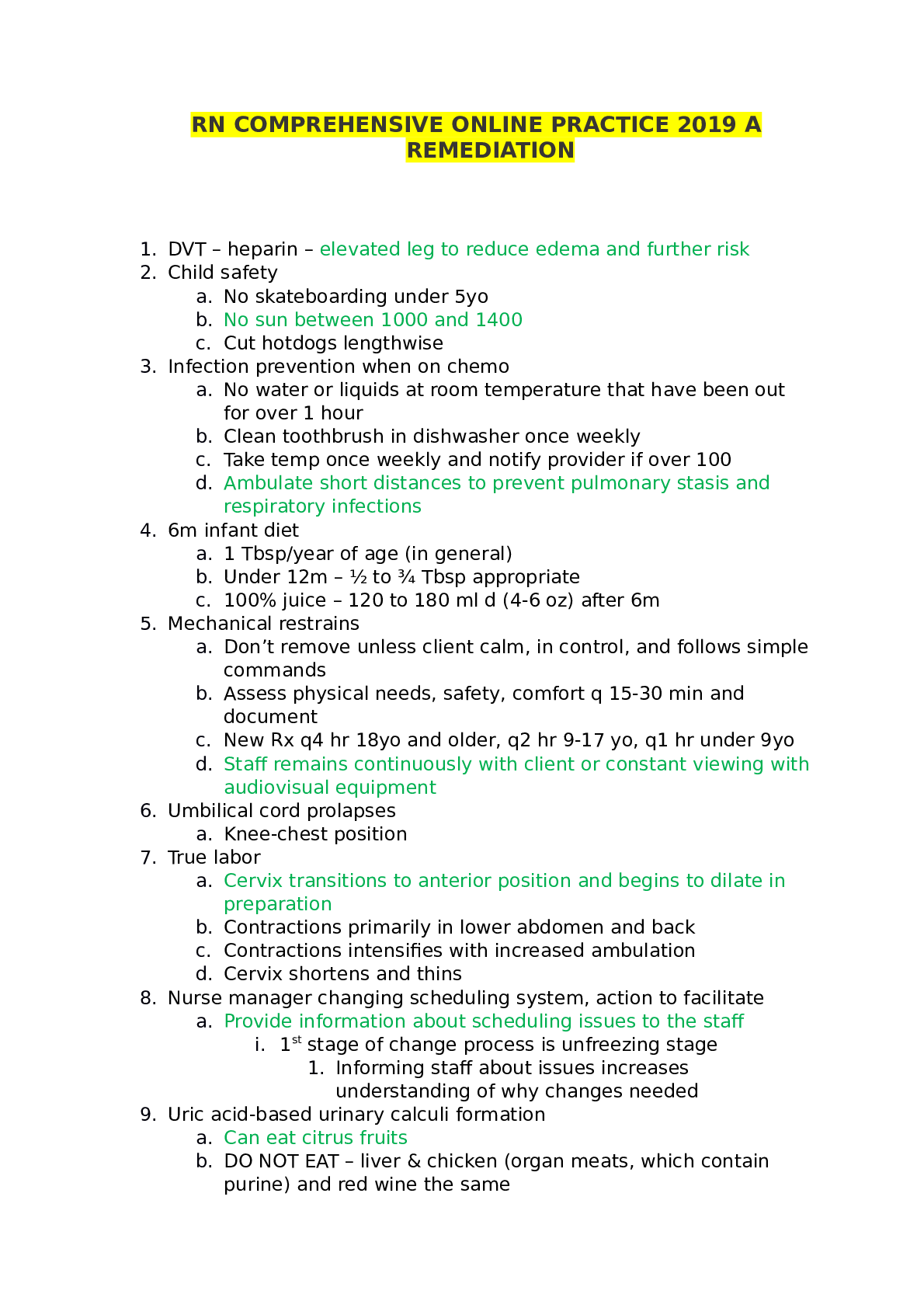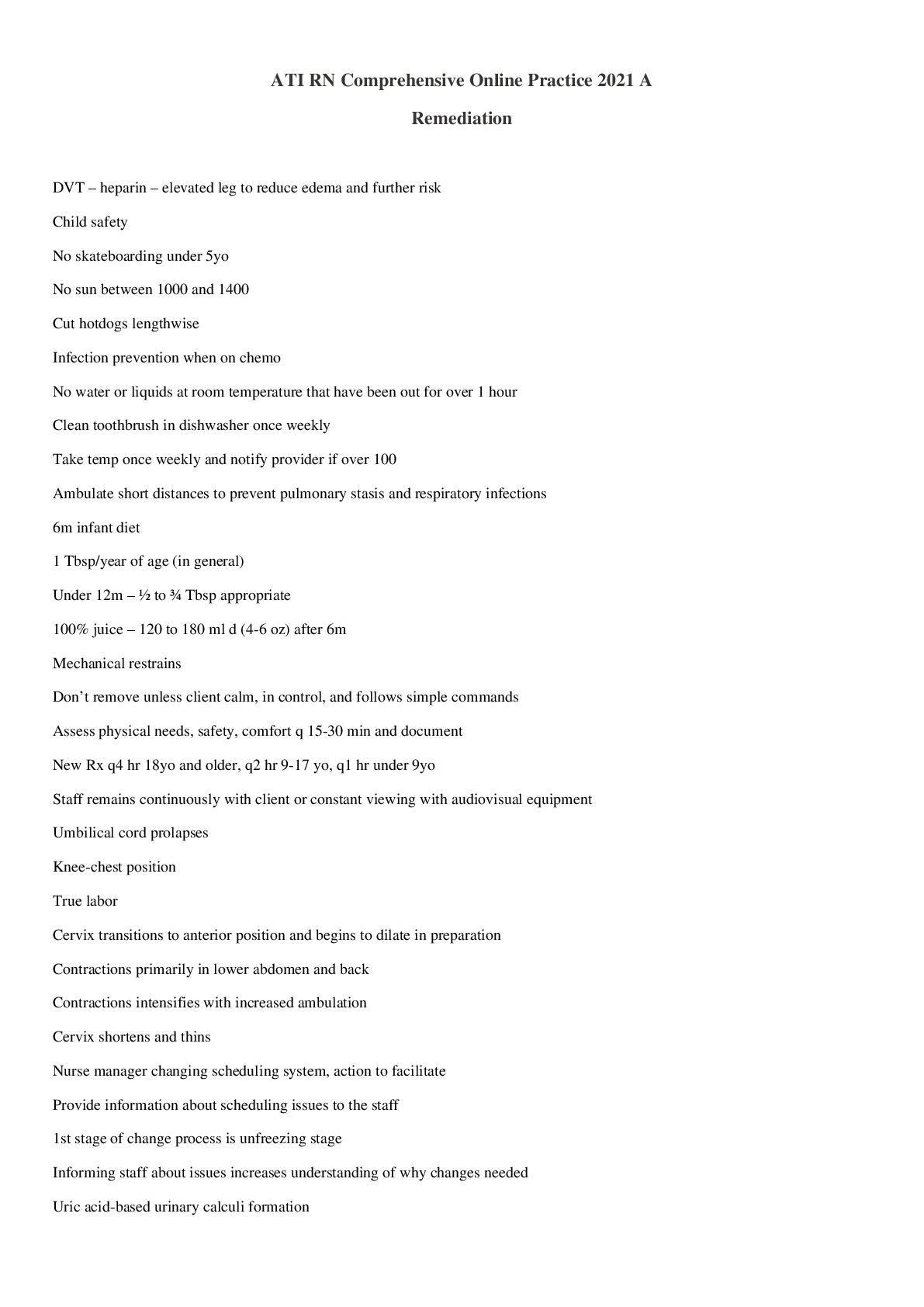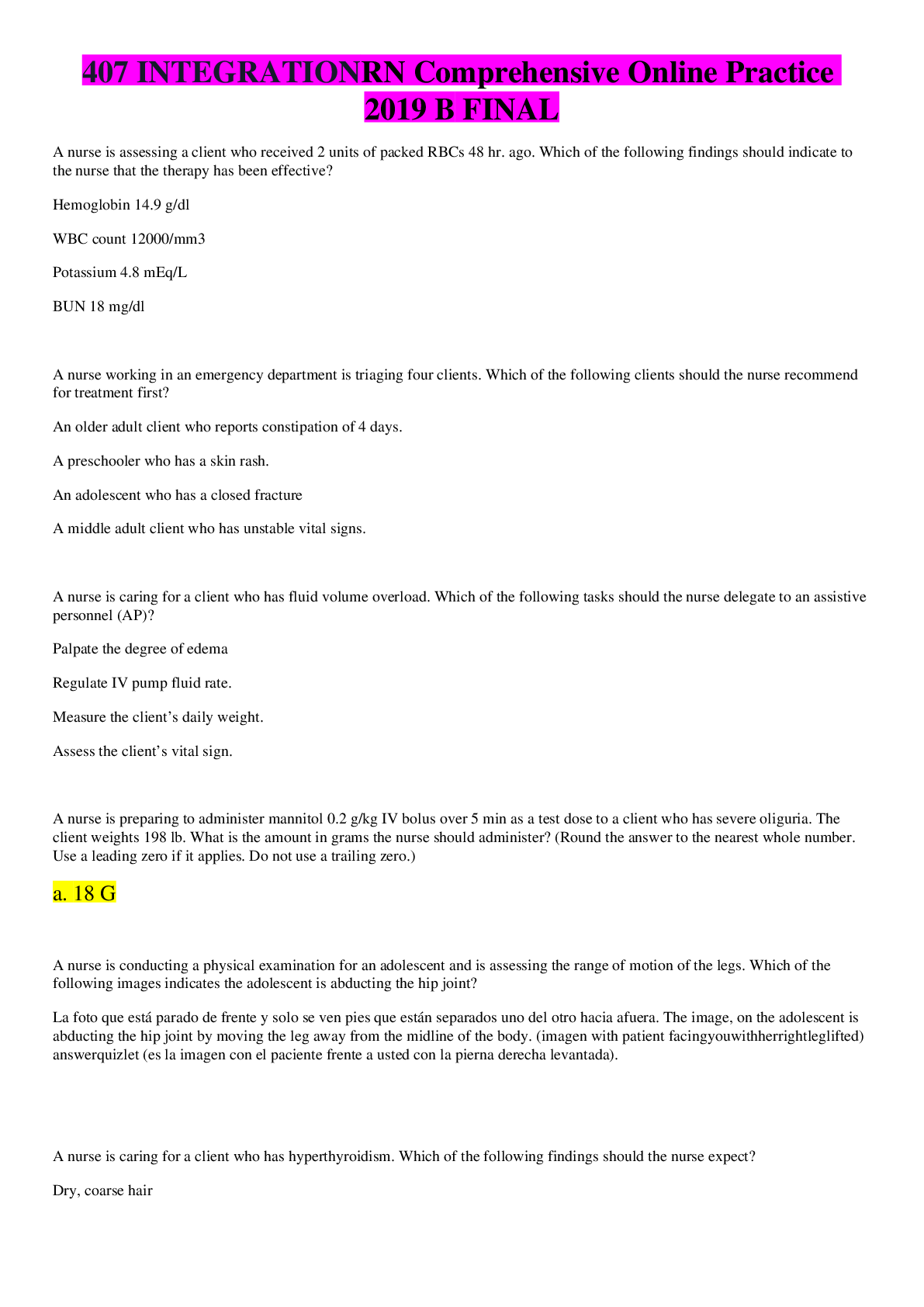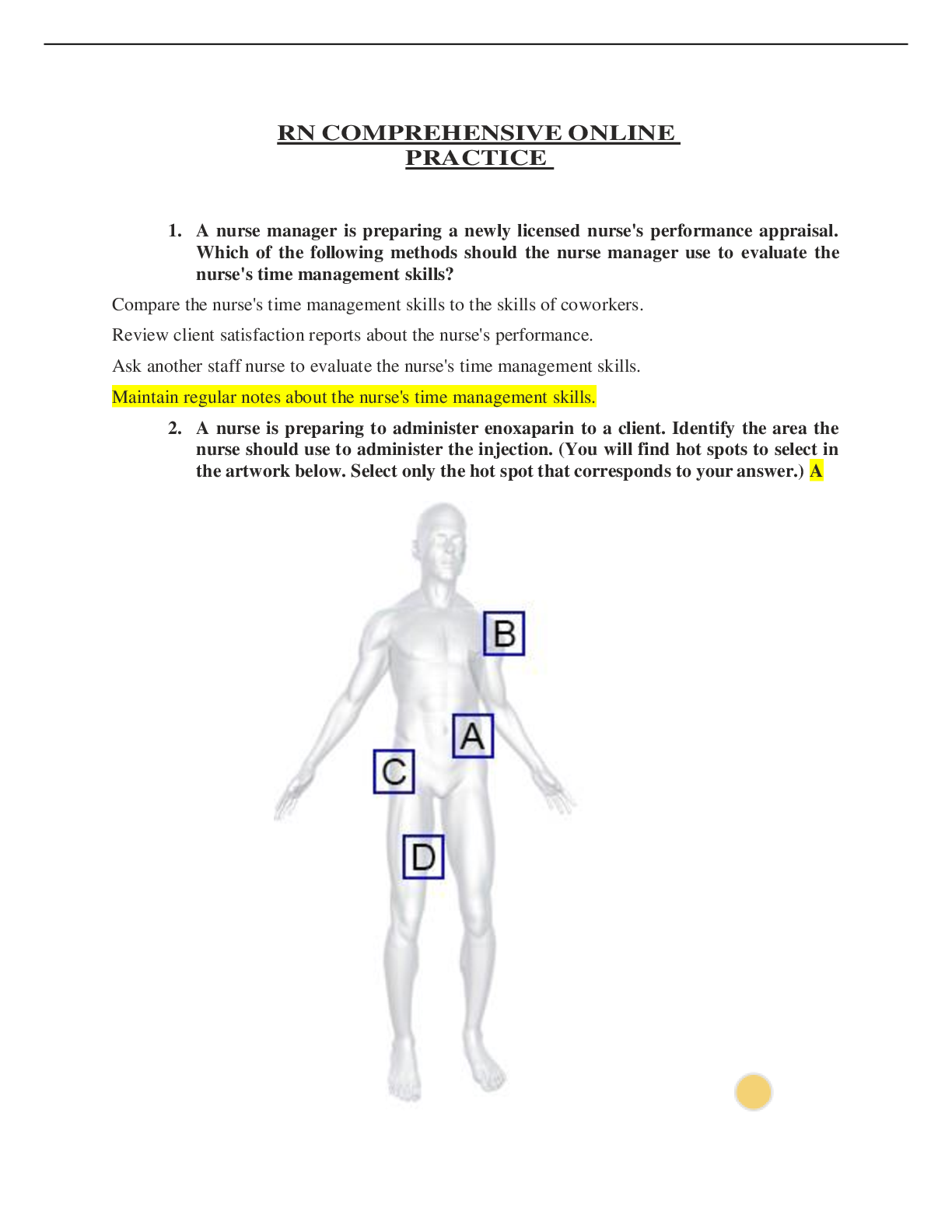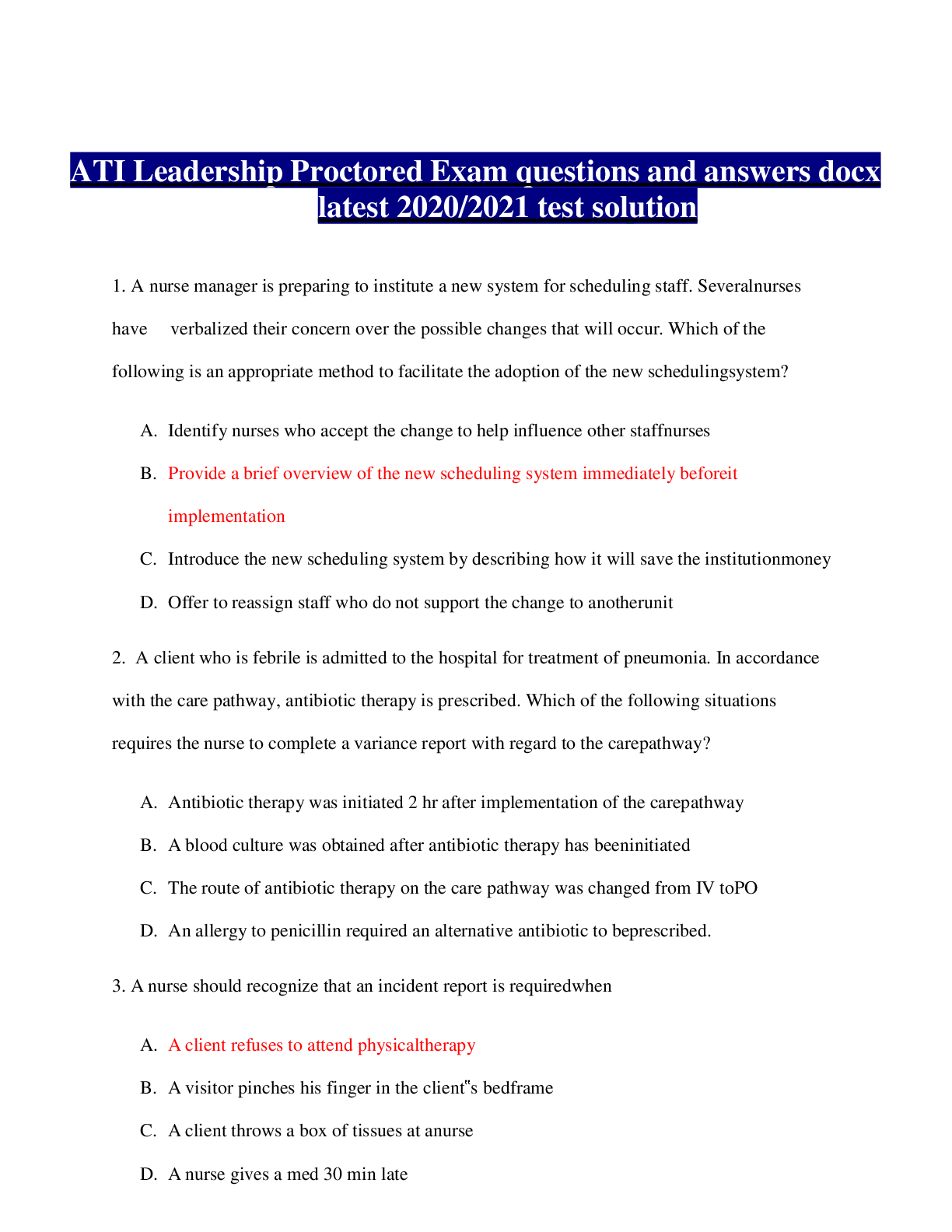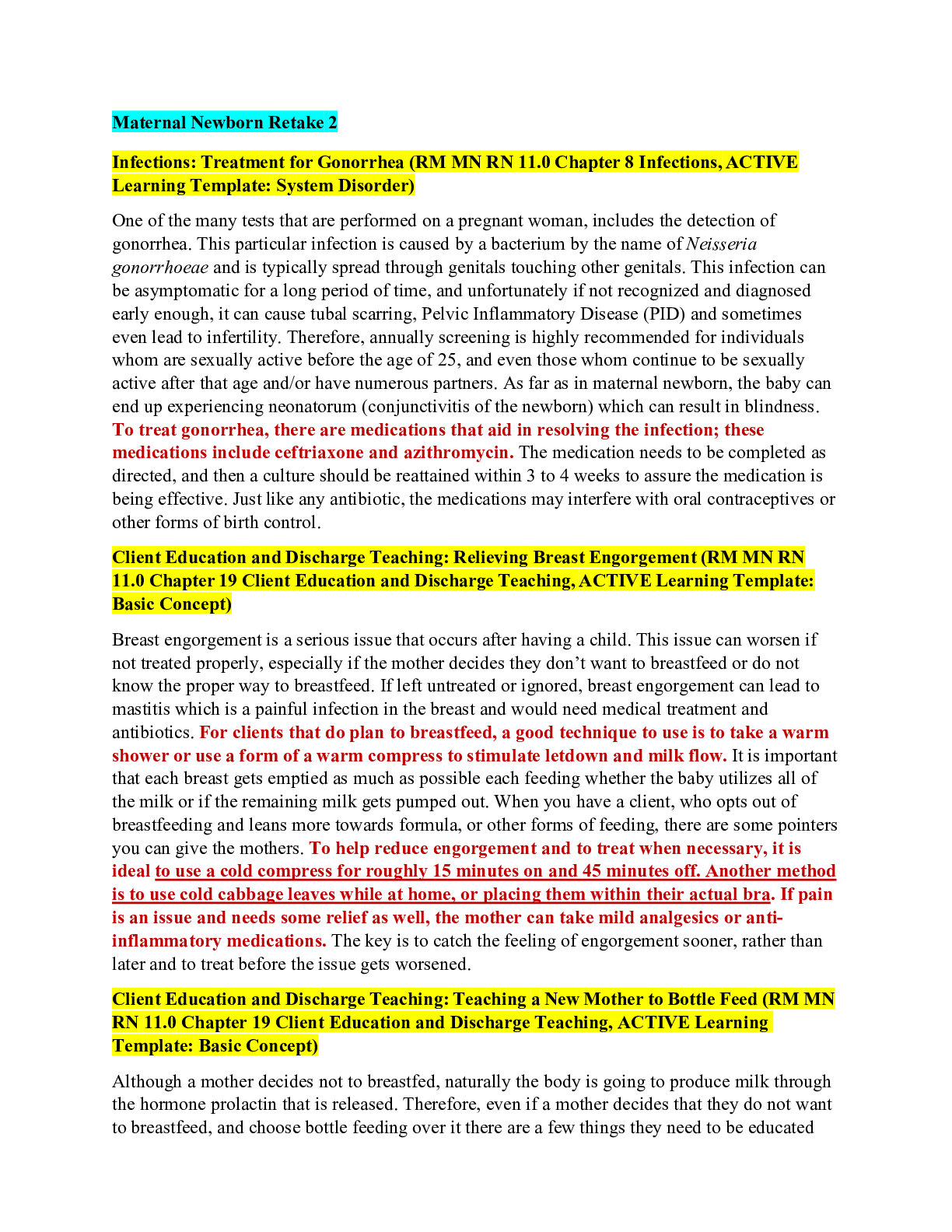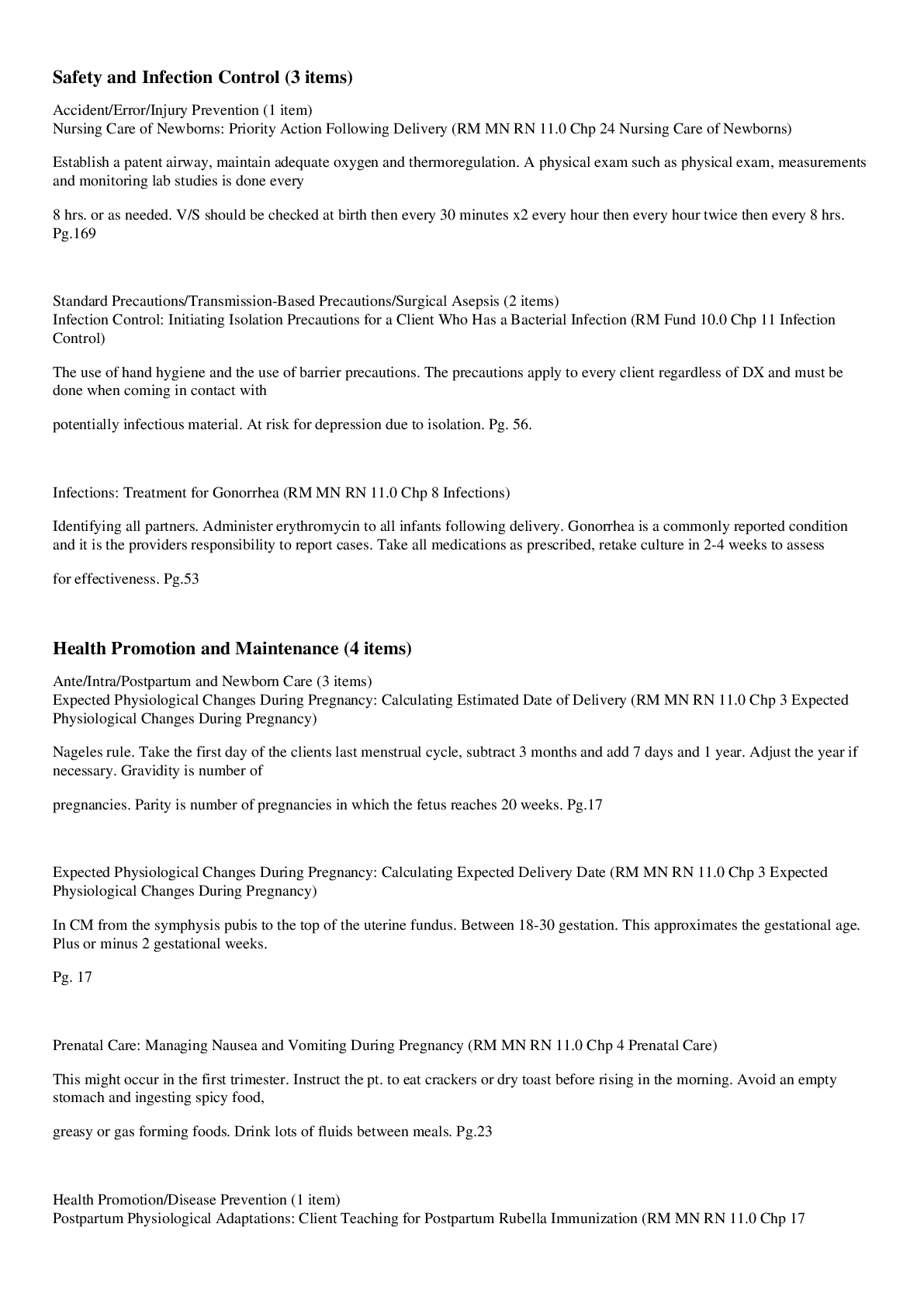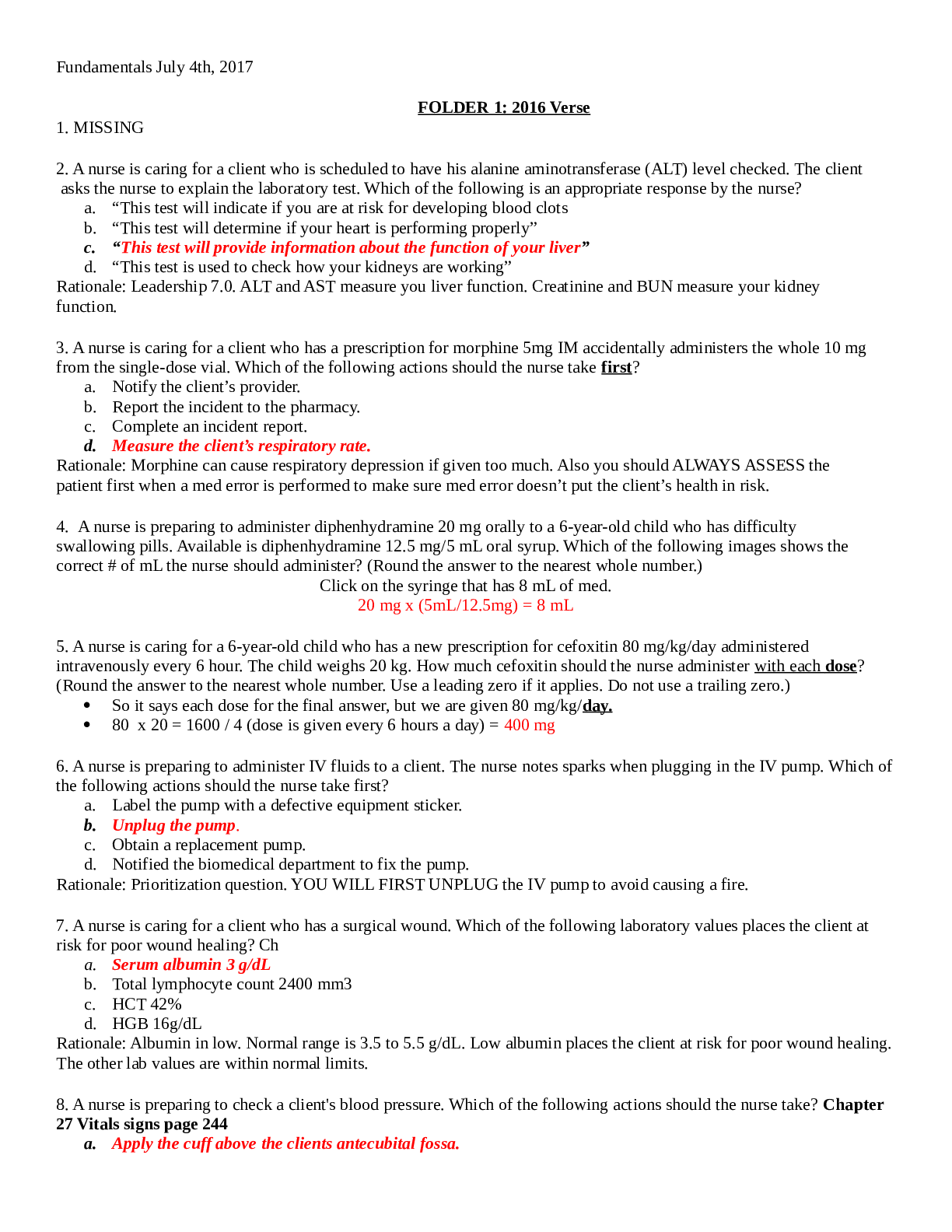*NURSING > QUESTIONS and ANSWERS > Focused Review: RN Comprehensive Online Practice 2019 B,100% CORRECT (All)
Focused Review: RN Comprehensive Online Practice 2019 B,100% CORRECT
Document Content and Description Below
Focused Review: RN Comprehensive Online Practice 2019 B Mobility and Immobility: Identifying a Prescription to Clarify with the Provider 1. Clients who have impaired sensory perception might feel nu... mbness, pain, or burning. 2. Use minor temperature changes and short-term applications of heat or cold for best results. 3. Do not use cold applications for clients who have cold intolerance, vascular insufficiency, open wounds, and disorders aggravated by cold (Raynaud’s phenomenon). Diabetic Neuropathy 1. Peripheral neuropathy includes focal neuropathies, caused by acute ischemic damage or diffuse neuropathies, which are more widespread and involve slow, progressive loss. This can lead to complications such as foot deformities and ulcers. 2. Autonomic neuropathy can affect nerve conduction of the heart (exercise intolerance, painless myocardial infarction, altered left ventricular function, syncope), GI system (gastroparesis, reflux, early satiety), and urinary tract (decreased bladder sensation, urinary retention). 3. It affects the autonomic nervous system, which minimizes manifestations of hypoglycemia (diaphoresis, tremors, palpitations) which can be dangerous for the client. Cancer Treatment Options: Caring for a Client who has Immunosuppression 1. Monitor skin and mucous membranes for infection (breakdown, fissures, and abscess). 2. Obtain prescribe cultures prior to initiating antimicrobial therapy. 3. Administer colony-stimulating factors such as filgrastim as prescribed to stimulate WBC production. 4. Assign the client to a private room and have the client stay in the room unless they need to leave for a diagnostic procedure or therapy. 5. Wash toothbrush daily in the dishwasher or rinse with a bleach solution. Tuberculosis: Transmission Prevention 1. Clients who have an airborne infection should wear a mask while outside of the room/home. 2. If splashing or spraying is a possibility, wear a full face (eyes, nose, and mouth) protection. 3. Use an N95 or high-efficiency particulate air (HEPA) respirator if the client is known or suspected to have tuberculosis. 4. Clients with measles, varicella, or tuberculosis should be encouraged to get adequate rest and nutrition 5. Encourage increased fluid intake or maintain IV fluid replacement to prevent dehydration. 6. Protect and maintain the client’s protective barriers (skin, mucous membranes). Musculoskeletal and neurologic systems: Performing Romberg Test 1. The nurse should ask the client to keep feet together, arms at both sided, and the eyes closed. 2. Expected findings are that the client stand with minimal swaying for at least 5 seconds. 3. Heel-to-toes walk is when the client walks in a straight line without losing their balance. Complications of Infants: Preventing Sudden Infant Death Syndrome 1. Secondhand smoke is a risk factor and when mothers smoke during pregnancy. 2. In addition, when infants co-sleeping with parents or adults. 3. Other risk factors are nonstandard bed (sofa, soft bedding, water beds, pillows), prone or side-lying sleeping, low birth weight, prematurity, low birth weight, and low Apgar scores. Prenatal Care: Evaluating Client Understanding of Common Prenatal Discomfort 1. Inform clients who do not plan to breastfeed that this will resolve on its own, but breast binders or support bras can be used, or an ice pack or cabbage leaves can be applied. 2. Inform clients who plan to breastfeed that breast care and frequent feedings will prevent or manage engorgement. 3. Observe for erythema, breast tenderness, cracked nipples, and indications of mastitis (infection in a milk duct of the breast with concurrent flu-like manifestations). Continuity of Care: Recognizing the Need for Referral to the Program of All-Inclusive Care for the Elderly 1. Provide information about support networks and community resources (child and adult day care; caregiver support groups). 2. Promote family unity. 3. Ensure safety for families at risk for violence. 4. Knowledge of community and online resources is necessary to appropriately link the client with needed services. 5. Discharge referrals are based on client needs in relation to actual and potential problems and can be facilitated with the assistance of social services, especially if there is a need for specialized equipment such as cane, walker, wheelchair, grab bars in bathroom). 6. Clients being discharged from health care facilities to their home can still require nursing care. Mental Health Issues of Children and Adolescents: Autism Spectrum Disorder 1. Promote positive reinforcement. 2. Increase social awareness. 3. Decrease environmental stimulation. 4. SSRIs can decrease aggression and antipsychotics and melatonin can help with insomnia. 5. Typical IQ less than 70. 6. Lack of empathy. 7. Unusual attachments to objects. Nasogastric Intubation and Enteral Feedings: Priority Action for a Clogged Percutaneous Gastrotomy Feeding Tube 1. Select interventions that maintain client safety while posing the least amount of restriction to the client. 2. If a client who has a high fall risk index is getting out of bed without assistance, move the client closer to the nurse’ work area rather than choosing to apply restraints. 3. Select interventions that are the least invasive. For example, bladder training for the incontinent client is a better option than an indwelling urinary catheter. 4. Elevate the head of the bed at least 30 degree during feedings and maintain the client in this position for approximately 60 min following completion of the feeding. 5. Administer bolus feedings over a period of 15 to 30 min. 6. Flush the tubing with 15 to 30 min and the flush the tubing with 15 to 30mL of warm water every 4 hr for continuous infusion, after measuring gastric residual, before and after bolus feedings, and between each medication administration. Chest Tube Insertion and Monitoring: Expected Findings 1. Keep two enclosed hemostats, sterile water, and an occlusive dressing located at the bedside at all times. 2. Due to the risk of causing a tension pneumothorax, chest tubes are clamped only when prescribed in specific circumstances, such as in the case of an air leak, during drainage system change, accidental disconnection of tubing, or damage to the drainage system. 3. Notify the provider immediately if the eyelets of the chest tube become visible, if drainage is above the prescribed amount or stops in the first 24 hr, or complications occur. Rheumatoid Arthritis: Planning Client Care 1. Encourage foods high in vitamins, protein, and iron. 2. Eat small, frequent meals. 3. Assist with and encourage physical activity to maintain joint mobility (within the capabilities of the client). Medications Affecting Blood Pressure: Adverse Effects of Captopril 1. Inform clients of the possibility of experiencing a dry cough and to notify the provider. Discontinue the medication. 2. Change positions slowly and lie down if feeling dizzy, lightheaded, or faint. 3. Advise clients to avoid the use of salt substitutes containing potassium. Monitor for manifestation of hyperkalemia (numbness and tingling) and paresthesia in hands and feet. Pharmacokinetics and Routes of Administration: Administering Insulin via an Insulin Pen Device 1. Educate the client on how to perform self-administration of subcutaneous insulin injections at a 45 or 90 degree angle and avoid aspirate for blood. 2. Rotate injection sites (to prevent lipo-hypertrophy) within one anatomic site to prevent day-to-day changes in absorption rates. 3. When mixing a rapid or short acting insulin with a longer acting insulin, draw up the shorter acting insulin into the syringe first and then the longer acting insulin into the shorter acting insulin vial. Dosage Calculation: Calculating Intermittent IV Bolus rate 1. If an electronic infusion pump is not available, regulate the IV flow rate using the roller clamp on the IV tubing. 2. When setting the flow rate, count the number of drops that fall into the drip chamber over 1 min. then calculate the flow rate using the drop factor on the manufacturer’s package containing the administration set. 3. Infusion pumps control anaccurate rate of fluid infusion. Infusion pumps deliver a specific amount of fluid during a specific amount of time. 4. Nurses calculate IV flow rates for large-volume continuous IV infusions and intermittent IV bolus infusions using electronic infusion pumps (mL/hr) and manual IV tubing (gtt/min). 5. Do not use trailing zero. 6. Nurses are responsible for administering the correct amount of medication to give. Nurses can use 3 different methods for dosage calculation: ratio and proportion. Formula (desired over have), and dimensional analysis. Total Parental Nutrition: Client Education 1. The nurse should assess vital signs every 4 to 8 hr and weights daily. 2. Follow sterile procedures to minimize the risk of sepsis including a mask when changing the central line dressing (per facility procedure). 3. Change tubing and solution bag (even if not empty) every 24 hour. 4. Do not use the line for other IV bolus solutions (prevents contamination and incompatibility). Nursing Care of Newborns: Maintaining Thermoregulation 1. Heat loss occurs by conduction: loss of body heat resulting from direct contact with a cooler surface. Preheat a radiant warmer, warm a stethoscope and other instruments, and pad a scale before weighing the newborn. 2. Convection is flow of heat from the body surface to cooler environmental air. Place the bassinet out of the direct line of a fan or air conditioning vent, swaddle the newborn in a blanket, and keep the head covered. 3. Evaporation is loss of heat as surface liwuid is converted to vapor. Gently rub the newborn dry with a warm sterile blanket (adhering to standard precautions) immediately after delivery. 4. Radiation is loss of heat from the body surface to a cooler solid surface that is close to, but not in direct contact. Keep the newborn and examining tables away from windows and air conditioners. Cystic Fibrosis: Creating a Plan of Care for a Child who has an Infection 1. Administer antibiotics through IV or aerosol specific to treat pulmonary infection. 2. Common medications include tobramycin, ticarcillin, or gentamicin. 3. High doses may be prescribed. Collect blood specimens before and after some IV antibiotics to maintain therapeutic levels. Burns: Resuscitation Phase of Burn Injury 1. During this phase, initial fluid shift occurs in the first 12 hr and continue for 24 to 36 hr. 2. Decreased sodium due to third spacing (hyponatremia) and increased potassium and chloride. 3. Total protein and blood albumin are decreased, possible metabolic acidosis, liver enzymes, urinalysis, and clotting studies. Heart Failure and Pulmonary Edema: Identifying Manifestations of Pulmonary Edema 1. Expected signs are coughing with pink, frothy sputum (key finding). 2. Tachypnea, dyspnea, and orthopnea. 3. Increased pulmonary artery occlusion pressure [Show More]
Last updated: 1 year ago
Preview 1 out of 4 pages
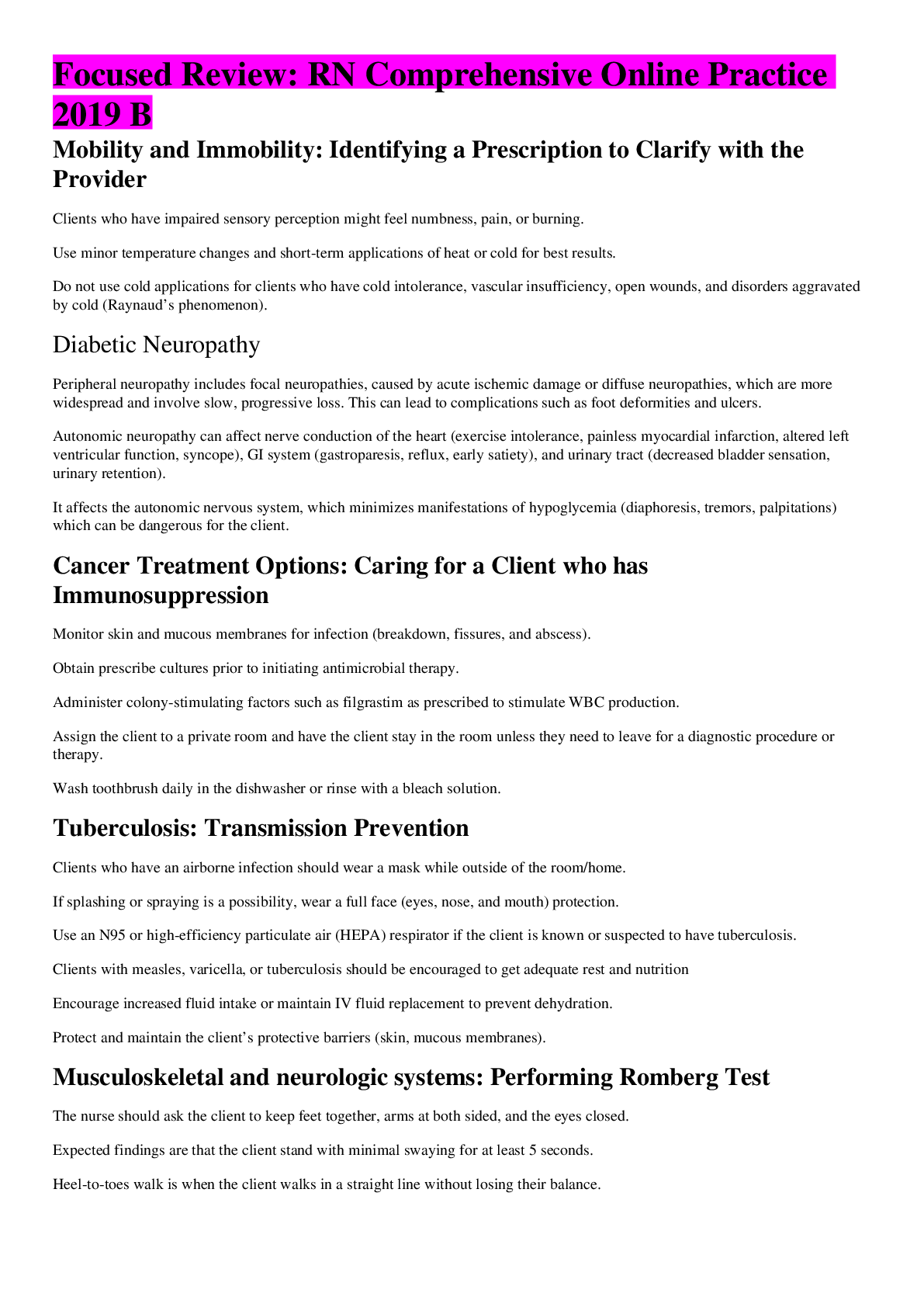
Reviews( 0 )
Document information
Connected school, study & course
About the document
Uploaded On
Mar 02, 2021
Number of pages
4
Written in
Additional information
This document has been written for:
Uploaded
Mar 02, 2021
Downloads
0
Views
31


